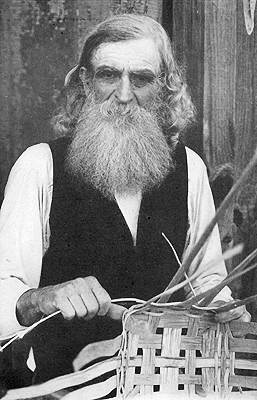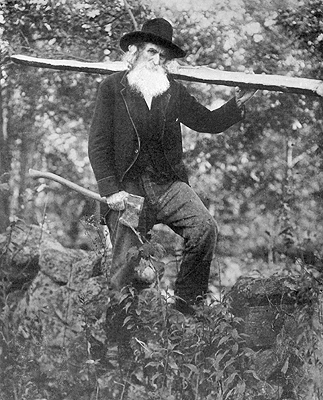| Join | Official Historian | City of Stamford | Blog | About Us | |
| Jewish Historical Society | Civil War Roundtable | Contact Us | |
|
|
|
|
THE BEAUTY OF THE WORKER AND THE WORK.By Edward F. Bigelow, ArcAdiA: Sound Beach, Connecticut.Guide to Nature Magazine, Vol. IX. January 1917. No. 8.
“Blessed are the pure in heart for they shall see God,” is but another form of expressing adaptation to environment or specific congruity. It is only the pure that shall know the highest purity. It is only to the merciful that mercy comes; it is only when we carry in the heart the appreciation of beauty that we see beauty. It is love, not fight nor hatred, that begets love. Blessed is the man who has found his work, because in work is real happiness. Strange, is it not, that human individualities are so diverse, and occupations so varied, yet how beautiful is the eternal fitness of things. President Wilson and Abraham Lincoln, though rather long faced and rather awkward when engaged in some occupations, are each really beautiful as presidents because each looks like a president, and is a president in nature. Have you ever thought, aside from all questions of the tariff, aside from all political differences, that many people in the past were not destined to become presidents of the United States because they did not look like presidents? There is a destiny that shapes our ends, even if the faces are hewn rather roughly. Walt Whitman sang of the beauty of the colored man on the truck wagon, because he was beautiful. The mail had found his job, and he harmonized with his surroundings. Humor has been defined as the juxtaposition of incongrous concepts. There may be a joke in things. That is why a circus clown is so funny, even when he says nothing. He does incongrous things, and we recognize the joke. ft would be a huge joke if a company of lawyers, ministers or bankers should take pickax and shovel, and get into a ditch. Would you not laugh until your sides were tired, at a company like that in such a place. That makes us laugh so heartily when a washerwoman is portrayed on the stage as becoming suddenly rich and entering “sassiety,” or when the hodcarrier inherits a hundred thousand from some distant relative, and immediately hires $150 chauffeur to run his Packard. We feel that something has gone astray. That is a joke. Some one has told us that a tobacco dealer and typical old-time tobacco chewer has inherited a million, and is ambitious to enter “high society.” He proposes to have an estate, and to paint a coat of arms on his automobile. H e ,confers with an expert on family crests :and seals, and says, “I want a picture put on my automobile door that will be emblamatic of an aristocratic family.” It so happened that the expert was not only well versed in the ancient lore of aristocratic families, but he had an undercurrent of humor, and recognized the fact that this tobacco merchant, suddenly transferred to an automobile, would be ridiculous with a false coat of arms, and decided to give him something expressive and classic too. Therefore he suggested, Quid rides, which might mean, “Why do you laugh,” or the Quid rides. Beauty like happiness, is only another form of fitness. The greater the adaptation, the greater the beauty or the happiness. There is, it is true, a fitness in the little child's dancing along by the roadside. We speak of it as the beauty of youth, but there is no less beauty in even the infirmity of age. The artist's eye perceives that as well as the beauty of youth. One likes to study an old man or an old woman as an ideally beautiful form, provided the setting is correct. But is there any thing more ridiculous than a gray-haired man or woman who assumes the gewgaws of youth, and tries to defer the approach of age by aping the manners of the young ones, insisting that he or she is as young now as ever. If, at my age, I should try to dance, I think I would do it alone in an empty room, and not make myself ridiculous, as some very elderly people do, by trying to be as lively and gay as they were sixty years ago. The precocious boy or girl is ridiculous, but the youthful octogenarian is more so. As we pass along the road of life, let us emulate the chameleon which alters his color to harmonize with his changing surroundings. It is only thus that we can avoid the absurdity of incongruity. Pardon these soliloquies, my kind reader! A naturalist must necessarily be a student of beauty. He revels in it, and sees it everywhere in nature, because nature is never incongruous. It is only silly human beings that try to struggle with the passing years. St. Paul was wise when he said that when he was a child he thought as a child, but when he became a man he put away childish things.
I wish that a greater number of human beings could see beauty in the eternal fitness of things. It is only from this point of view that real democracy will be attained, and all class distinction fade away. The man with the hoe is a subject for the best painter or poet of the land. The hodcarrier climbing a ladder with his load of brick is as beautiful and noble, provided he is fitted to his surroundings, as is the banker at his desk or the preacher in the pulpit. The little children in their folk dances upon the lawn, or when circling around their Maypole, are charmingly beautiful, but fully as pleasing or perhaps even more pleasing are those two old Italian women, plainly dressed, trudging along the country road and carrying a bundle of sticks on their heads. Appreciation of beauty will attract the artist's brush or the photographer's camera and as agreeably to the one as to the other. In searching for beauty I have for a long time admired an aged basket maker that lives in the northern part of Stamford. He has been pictured in our pages, but the more I consider his patriarchal, picturesque beauty, the more have I desired to let the reader see him again. The artistic eve of the sculptor, the famous Gutzon Borglum, selected him as the original of The Pioneer in one of his equestrian masterpieces of that name. This has made Rezzo [sic] Waters famous, and he has been sought by merchants everywhere to demonstrate in their show windows the art of basket making. It is not the making of baskets, nor the man that is doing it, that attracts attention, but the unusual portrayal of beauty. Human beings are lovers of beauty. Wordsworth, speaking of a charming young girl, said: “Her beauty made me glad.” Beauty gives pleasure. That is our reason for printing Mr. Waters' picture in this number of THE GUIDE TO NATURE. For the same reason he is shown by the sculptor, or in the window of the enterprising merchant. A crowd might gather around a drunken man, but the point of view would be that of ridicule or pity, because we recognize the fact that a human being in that condition is out of place. Basket making is a disappearing arts. It savors of the days of long ago. There is an old-fashioned quaintness about it that seems to harmonize with colonial houses and old-fashioned customs. It is fitting that a basket maker should be well advanced in years. I know that basketry is taught in the schools of the present day, but I never think of it as real basket making. It is only busy idleness. You may not be interested in basket making, and we have no desire to initiate you in the art, but to make careful study of things that are naturally fitting, pleasing and adapted to their environment comes within the scope of this magazine. We therefore present with no little personal satisfaction these photographic studies for your careful inspection, and we extend to Mr. Rezzo Waters our hearty thanks for his kind permission to make the studies. Photo Selection of the Month, April 2006 |
|
||
|
|

